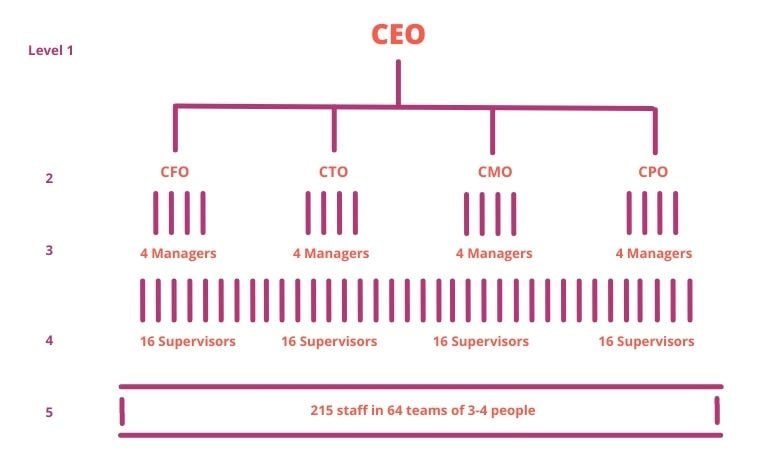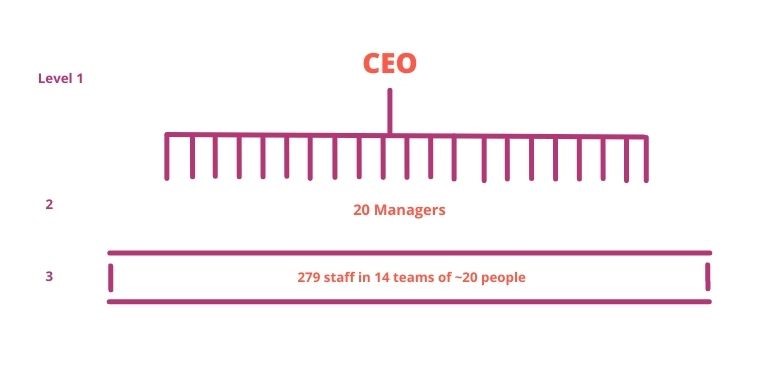A tall organization is one that has many horizontal layers of management, from the top to bottom.
Whereas top-down or bottom-up organizations describe how decisions are made throughout the organization, the tall/flat-ness of the organization refers to how many levels of hierarchy there are.
Tall organizations have multiple layers, and their organization chart looks like a steep, thin pyramid, as compared to flat organizations that have few layers, and are relatively wide.
Tall organizations have been around the longest, outnumber flat companies and are common among large departmental-style, administrative businesses.
.jpg?width=780&name=F%20internal%20-%20780%20x%20455%20(1).jpg)
Faster, nimbler businesses tend to prefer a relatively flat structure, even if they have many thousands of employees. Google has successfully deployed a flat organizational structure in recent years.
Why Grow Tall?
As companies grow, so the temptation is to add layers of management, in order to delegate authority throughout the organization. With business becoming too complex for one level of management to coordinate, layers are often added below.
However, this has been found to create isolated silos of information, ‘little empires’ for certain managers to rule, and put significant distance between the executive team and those closest to the customers - the front-line employees.
Communicating up and down a tall structure can be onerous, with ‘Chinese Whispers’ and misunderstandings causing breakdowns in coordination.
Layers upon layers of management can also build up ongoing costs in the organization, making it uneconomic, bloated and slow to move.
Modern management theory has found that fast-growing, agile and responsive organizations have tried to remove layers of management. In so doing, they look to regain the advantages of being 'small'. Large organizations have looked for productive ways of managing large numbers of employees without adding more hierarchy.
Layers vs. Span of Control
There is a general trade-off between the number of layers a company has and the span of control (direct reports) of the managers.
For example, if a company had 300 managers and staff, it would have to place employees in various teams, each run by and reporting to a manager. If each manager had 4 staff directly reporting to them (a ‘span of control’ of 4), then it would require 5 layers of management in total. This would create a relatively tall organizational structure, with 81 different teams, each with its own leader.
In the case of the tall organization, each manager would only have a few people reporting to them (4), so each team would feel ‘close’, although there would be some distance from the top of the organization to the bottom (5 layers). And the bottom would feel a long way from the top.
300 staff: Span of Control 4, leading to Tall Structure with 5 Levels

By contrast, if the same company of 300 people had a span of control increased to 20, then the organization would only need 3 layers. This would be a relatively flat organizational structure, with only 21 teams (and team leaders) in total.
With teams of 20 reporting to each manager, each team leader would feel busy, with lots of reporting and staff to manage, although the top of the organization and bottom would feel closer together.
300 staff: Span of Control 20, leading to Flat Structure with 3 Levels

Tall or Flat?
Some large companies - such as Google, Canva and others - have managed to keep their organizations relatively flat, using cross-functional teams, holocracies or matrix structures.
Search the Harvard Business Review for articles about 'tall structures' and you will find no articles, yet there are dozens extolling the virtues of 'flat'.
Naturally, there are advantages and disadvantages associated with tall organizations.
Advantages of Tall Organizations
In general terms, the benefits of tall organizations are:
- more opportunities for promotion for staff
- as a result, extra motivation for staff, and better staff retention
- staff enjoy close support from their line manager
- high degree of supervision as each line manager has a limited number of people they are responsible for (narrow span of control)
- clear management structure
Disadvantages of Tall Organizations
By contrast, the limitations and weaknesses are:
- many levels of hierarchy
- long chains of command are long, slowing down communication through the organization
- organization is less responsive to change
- can be expensive to run due to high wage costs (many managers)
- restricted freedom and authority for staff members
 : Flat or Tall, Use Functionly to Guide You!
: Flat or Tall, Use Functionly to Guide You!
Whether you favor a tall or flat organization, or some combination of either, Functionly is here to help. You can set up the structure your organization in an online environment, and test out various scenarios.
Our drag and drop feature makes it so easy to use. You can then observe the consequences of various structural options. Get the structure right, design the work right, and great things can happen. It's too important to be left to chance.
Sign up for your Functionly free trial today, and start mapping out the best way forward for you.
~~
Sources
- Tall Organizational Structures, S Quain, Small Business, 6 Feb 2019
- Tall Organization vs. Flat Organization: What’s the Difference? Indeed, 5 Aug 2021




